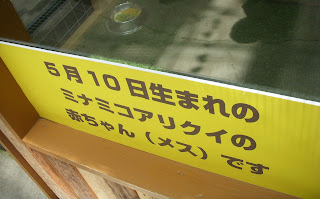I just got back from a short trip to the Keihanshin region in Japan. Due to an oversight in scheduling, I did not get to visit the main zoo of the region, the Kobe Oji Zoo. Instead, I went to a different zoological institution, Kobe Animal Kingdom, which differs from a traditional zoo in its focus on getting visitors close to the exhibited animals and frequently encouraging interaction between them. Naturally, this raises ethical concerns.
The sight of several owls chained to a log did not inspire confidence. Even though they were not open to visitor interaction, they were still kept in remarkably close proximity to guests and to one another (despite some of the owls being large enough to prey on the others). This is one of the smaller owls present, a tropical screech owl.
On the larger end of the spectrum, a Verreaux's eagle owl.
Most of the other animals, however, were kept in much better conditions. The main portion of the attraction is a large greenhouse divided into multiple large rooms where the animals are housed. There was ample space for the inhabitants and, as far as I could tell, most if not all of the birds were flight-capable. The entire facility is kept very clean and the animals generally looked healthy. At least some of the rooms had off-hours that gave them respite from visitor attention. One of the largest rooms contained a big pool with numerous waterbirds, including this African crowned crane.
The birds appeared to breed freely, as fenced-off areas next to the footpaths where nests had been built were not uncommon. Here's one such area containing juvenile black-winged stilts.
At the center of the pool was an island where ring-tailed lemurs and sitatunga were kept, though they were free to move around the rest of the room, as shown by this sitatunga taking a dip. (The lemurs, on the other hand, were able to leap to the sides of the pool via branches.)
Another room had a variety of tropical arboreal birds, such as these violet turacos.
A green turaco.
Toco toucans and a red-billed toucan sitting near the exhibit signs.
Kobe Animal Kingdom does have a few animals that are kept behind barriers, entirely out of reach of visitors. This is a juvenile tamandua. It was not clear to me why it was separated from its mother, but there were adult tamanaduas in an adjacent enclosure that are presumably its parents. Yes, that is a plush anteater it is lying on top of.
Coincidentally, it shares my birthday (May 10th).
Some two-toed sloths. Despite being out in the open, they were off-limits to visitors. They also had an alternate, enclosed exhibit next to the tamanduas.
The main interactive animals in the next room were maras and capybaras.
Fenced off to the side were American beavers.
There was also a South American fur seal.
An African wetland display housed this blacksmith plover.
The stars of the show, however, were the shoebills.
Their nesting platform.
Some small African mammals were kept behind glass, including this rock hyrax. Note the prominent incisors, betraying its affinities with elephants and dugongs.
A fennec fox.
In the back of the facility were a number of exhibits for raptors and small carnivorans. I suspect the chained owls I saw early on usually live here. Out of all the enclosures here these were probably the most lackluster, both in terms of aesthetic design and animal welfare, most of them looking very cramped and bare. Here are a group of ring-tailed coatis.
A rufous-legged owl.
A great horned owl.
There's an outdoor section of Kobe Animal Kingdom as well. Domestic animals such as horses and sheep are kept there, but there is also a flock of African penguins.
The red kangaroo paddock provided many opportunities for close observation of their anatomy. Note fused digits II and III and greatly enlarged digit IV on the foot of this kangaroo.
As always with Japan, the merchandise is worth mentioning. Among the items for sale were these bookmarks featuring an incredibly large diversity of animals, some of them very obscure.
Alas, most of their prehistoric animals were not scientifically up to par. They have the colors of Sinosauropteryx correct, at least.
Plush shoebills!
A large plush wombat (and a smaller companion).
Models of several dinosaur skeletons (an unnamed dromaeosaurid, Fukuisaurus, and Fukuiraptor).
There were even shoebill crackers.


















































No comments:
Post a Comment